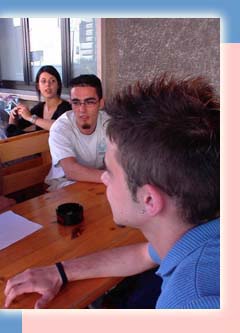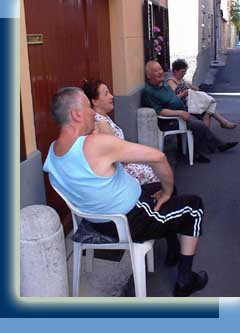| |
|
|
|
|
|
|
|

|
|
Previous Page |

|
 "Did you know the
oldest structures were built out of stones from the surrounding mountain?"
asks Romeo, a townsman willing to talk but not to divulge his last name.
Enjoying the first cool breeze of the afternoon, Mario Gazzetta and Romeo,
the owner of a jewelry shop, sip iced coffee under the welcoming awning
of Café Commercio. Both men are natives of Cagli; Romeo has lived here all
his life. Mario has traveled extensively all over Italy and owns houses
in Cagli, Bologna, and Gabricce. They share a nostalgic view of Cagli, and
reminisce about the past 20 years. It was two decades ago when Italy went
urban, causing hordes of people to flood the cities. The formerly rural
immigrants did not have a connection to their new surroundings. Not having
ancestral ties to the architecture, according to Mario has made things worse.
"There used to be a relationship between the people and the architecture,
the buildings. Not anymore," says Mario, "now everybody wants to destroy
everything." "Did you know the
oldest structures were built out of stones from the surrounding mountain?"
asks Romeo, a townsman willing to talk but not to divulge his last name.
Enjoying the first cool breeze of the afternoon, Mario Gazzetta and Romeo,
the owner of a jewelry shop, sip iced coffee under the welcoming awning
of Café Commercio. Both men are natives of Cagli; Romeo has lived here all
his life. Mario has traveled extensively all over Italy and owns houses
in Cagli, Bologna, and Gabricce. They share a nostalgic view of Cagli, and
reminisce about the past 20 years. It was two decades ago when Italy went
urban, causing hordes of people to flood the cities. The formerly rural
immigrants did not have a connection to their new surroundings. Not having
ancestral ties to the architecture, according to Mario has made things worse.
"There used to be a relationship between the people and the architecture,
the buildings. Not anymore," says Mario, "now everybody wants to destroy
everything." |

Davide Santini and Andrea Aceri are two teenagers who wish there was more to do in Cagli
|
 From
left: Piero Giavanotti, Assunta Martinelli, Mariano Luchini, and Egiziana
Bettini live with all members of their families in Cagli and believe it
offers enough opportunities for young people
From
left: Piero Giavanotti, Assunta Martinelli, Mariano Luchini, and Egiziana
Bettini live with all members of their families in Cagli and believe it
offers enough opportunities for young people
|
 "When they built
new Cagli, they made beautiful houses but forgot the factories," says Romeo. "When they built
new Cagli, they made beautiful houses but forgot the factories," says Romeo.
 The number of university-educated
youth in Cagli is steadily increasing, while job opportunities are not. The number of university-educated
youth in Cagli is steadily increasing, while job opportunities are not.
 "A large number
of children are forced to leave Cagli to find jobs," observes Assunta, "but
across the river there are many factories." "A large number
of children are forced to leave Cagli to find jobs," observes Assunta, "but
across the river there are many factories."
 According to Mario,
however, during the last twenty years, most of the factories and "activity"
of the Commune of Cagli have been swallowed up by the larger surrounding
cities. Assunta is adamant that there are multiple job opportunities to
be found in the area. Progetto Scuola Lavoro, is a city-run organization
that give work experience to Cagli youth. Throughout the summer, Cagli shop
owners hire 14-17 year-old students to work part-time. The kids work about
four hours a day and earn roughly 200 euro a month. Romeo, however, is not
confident that there are enough opportunities for youth returning to Cagli
from college. According to Mario,
however, during the last twenty years, most of the factories and "activity"
of the Commune of Cagli have been swallowed up by the larger surrounding
cities. Assunta is adamant that there are multiple job opportunities to
be found in the area. Progetto Scuola Lavoro, is a city-run organization
that give work experience to Cagli youth. Throughout the summer, Cagli shop
owners hire 14-17 year-old students to work part-time. The kids work about
four hours a day and earn roughly 200 euro a month. Romeo, however, is not
confident that there are enough opportunities for youth returning to Cagli
from college.
 "The future for
the children," says Romeo, "is to go away." "The future for
the children," says Romeo, "is to go away."
 A few blocks away,
at Piazza Papa Nicolo IV, an extremely different view explodes from the
mouths of the Cagliesi youth. A few blocks away,
at Piazza Papa Nicolo IV, an extremely different view explodes from the
mouths of the Cagliesi youth. |
 "I want to launch a campaign to get rid of everything that is old," pronounces
Marco Cometti, a 17-year-old sporting a silver nose ring that matches his
cell phone. Outside Café del Teatro, roughly twenty kids lounge around the
brightly colored tables, drinking Fantas, chain-smoking, and talking on
their telefoninos to the three remaining kids in town not within their immediate
sight. Marco, like his friends Davide Santini, 19, and Andrea Aceri, 16,
proclaims eternal boredom with their daily routine. Andrea, unlike the rest
of his friends, works with his uncle as a carpenter instead of going to
school, and languishes over the absence of a McDonalds and the recently
closed movie theater.
"I want to launch a campaign to get rid of everything that is old," pronounces
Marco Cometti, a 17-year-old sporting a silver nose ring that matches his
cell phone. Outside Café del Teatro, roughly twenty kids lounge around the
brightly colored tables, drinking Fantas, chain-smoking, and talking on
their telefoninos to the three remaining kids in town not within their immediate
sight. Marco, like his friends Davide Santini, 19, and Andrea Aceri, 16,
proclaims eternal boredom with their daily routine. Andrea, unlike the rest
of his friends, works with his uncle as a carpenter instead of going to
school, and languishes over the absence of a McDonalds and the recently
closed movie theater.
 "We would like to
get out of Cagli and go to Bologna," says Marco of future travels. Marco
and his friends try to travel as much as possible to bigger cities all over
Italy. Rome, Milan, and Sardinia are some of the favorites, along with destinations
as far away as Barcelona or even Greece. "There are no chances to do anything
special," says Davide, who has taken up permanent residence at the Café
del Teatro tables, "There is only one swimming pool, which is crap. On the
weekends the only thing to do is get drunk." "We would like to
get out of Cagli and go to Bologna," says Marco of future travels. Marco
and his friends try to travel as much as possible to bigger cities all over
Italy. Rome, Milan, and Sardinia are some of the favorites, along with destinations
as far away as Barcelona or even Greece. "There are no chances to do anything
special," says Davide, who has taken up permanent residence at the Café
del Teatro tables, "There is only one swimming pool, which is crap. On the
weekends the only thing to do is get drunk."
 The older residents
of Cagli agree that weekend activities are a problem, but for different
reasons. Mario's smile saddens and disappears as he comments on the weekend
activities of Cagliesi youth. According to Mario, on Saturday nights the
town is turned upside down by the rambling adolescents. The older residents
of Cagli agree that weekend activities are a problem, but for different
reasons. Mario's smile saddens and disappears as he comments on the weekend
activities of Cagliesi youth. According to Mario, on Saturday nights the
town is turned upside down by the rambling adolescents.
Click to Continue to
the Last Page...
| 
|

|
Text by Deirdre Mullins, Photographs by Deirdre Mullins and Marissa Norkus
Graphics, Page Design & Layout by Diana Richardson
The Loyola College Cagli Project Main Page
|



 From
left: Piero Giavanotti, Assunta Martinelli, Mariano Luchini, and Egiziana
Bettini live with all members of their families in Cagli and believe it
offers enough opportunities for young people
From
left: Piero Giavanotti, Assunta Martinelli, Mariano Luchini, and Egiziana
Bettini live with all members of their families in Cagli and believe it
offers enough opportunities for young people

